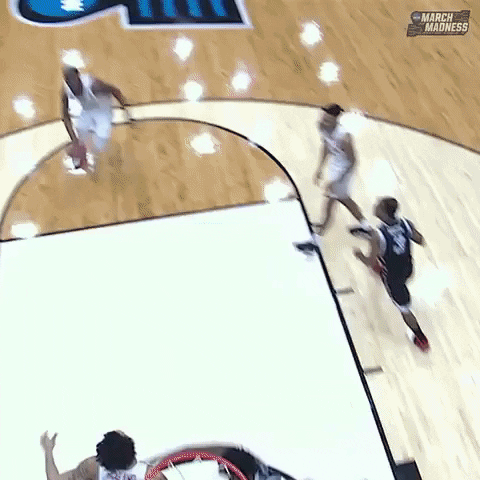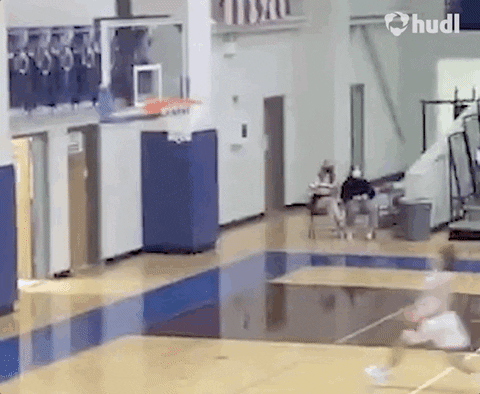Vertical Jump Training: Dunking Made Easy
When we are trying to improve jumped-based training for basketball players, we have to recognize some key concepts. To begin, we have to improve our landing mechanics unilaterally (on one leg) and bilaterally (on two legs). When we improve our landing mechanics we will also improve our jump mechanics, our actual lift-off mechanics.

A lot of basketball players have to jump from one leg both laterally and vertically. Basketball athletes also have to jump laterally or vertically from two legs. We have to train all of these aspects. This takes us into our first key exercise.
1. Single-Leg Side Jump
This is a pretty simple movement. With the rear leg raised, held up on a pad, bench, box, or anything that puts the back foot above the hips. With the front leg, just a little above 90 degrees, jump onto a plate at about 5-8” of height. Pause briefly on the landing. Then for the next rep head back to the floor and immediately jump back onto the plate. The focus is on the lateral drive and really controlling the landing position. Do this for two to three sets of five to ten reps on each leg.

2. Depth Drop Into Box Jump
We can’t stress enough the need to improve landing mechanics and be able to react quickly. That next concept utilizes a depth drop. A depth drop involves dropping off of a box; the depth drop can be anywhere from 8” up to 20”. We have to build to that point.

What we like to do at Garage Strength is to do a depth drop, land bilaterally, and then jump onto another box around 30” and land on one foot. The key here is to learn how to absorb energy off that first initial depth drop and apply a lot of force bilaterally (this will help improve dunking capability). The landing is then unilaterally. Think about going for a layup and landing on one foot. It is important to be stable in the ankle, knee, and hip during that landing.
The key with this movement is that it will teach athletes how to use energy to jump higher but will also teach an injury prevention mechanism by landing unilaterally. When we land, we want to be nice and stable and pause in that position. Now as the strength and speed increase with the movement, we want to increase the box for the depth drop. Athletes do not need to go higher than 18 to 20” with the depth drop.
Do this movement for two to three sets of five to ten reps on each leg twice a week to learn how to ground properly both bilaterally and unilaterally for better dunking capability.
3. Overhead Jump Step Up
This is another unilateral movement, but now we are going to be performing the movement with our hands over our heads. We need to think about playing defense. We have to think about reacting quickly without having our arms to be able to be used as increasing our momentum vertically. Often in basketball, playing defense, we can’t have our hands up, drop them, and then jump. We have to be able to jump in that overhead position. That’s why we really like this exercise.
This exercise is a key component behind transferring jumping ability to the court. The movement is not only jump-based training but is specific to positions we are in on the court.

For this movement a 20” box is plenty. However, it is important to look at the length of the athlete’s tibia. So an athlete who is 6’5” or taller, their tibia is probably longer and they can go from 20” to 24”. The whole goal is focusing on touch and go with a big drive.
A lot of people might initially short-change the drive. Yes, they will hold the plate overhead but will fail to drive. We want to see a long, fast drive where the knee and hip end up in full extension. Do two to three sets of six to ten alternating reps. This will help improve speed on the court, thoracic stability, reaction unilaterally, and will help improve dynamic trunk control because of being in that overhead position.
4. Banded Side Jump Into Press
These next two exercises we like to use as a superset to help improve lateral reaction. This will help with defensive work, cutting in the paint, and better layups or dunking.
We want to have a band, preferably a PowerLastic band, attached to an immovable object at around chest height. We want to think about the PowerLastic band pulling us in for us to plant and drive from the hip to jump laterally away. Then as we land, we want to have tension across in the trunk. This carries over really well to agility.

We first jump in, to where the band is anchored, plant, jump, land, and press. We will feel this in the gut, hamstring, on the grounding leg, and in the glutes. Do this movement for two to three sets of five to ten reps on each leg. This will also help to increase coordination.
We want to rest thirty to forty-five seconds before starting the next movement.
5. Single-Leg Side Jumps
This movement helps with agility, power, speed, and with jumping. All things that help improve dunking capability.

With mini-hurdles set up, jumping and landing unilaterally, we diagonally jump side to side over the hurdles. Make sure to pause on the landing after the last jump. The main goal is to focus on landing mechanics thus the isometric action at the end. Isometrics actions will improve landing mechanics.
Recap
When athletes improve their landing mechanics as tall people, they are able to apply greater force when they are trying to jump. Utilizing all of these movements once or twice a week will help improve dunking capability, layup capability, and defensive capability. The overall improvement in agility pays off as well. Give the exercises a go and let us know how it goes.
DANE MILLER
Dane Miller is the owner and founder of Garage Strength Sports Performance. He works with a select handful of clients on building comprehensive programs for fitness and nutrition. Several times a year he leads a workshop for coaches, trainers, and fitness enthusiasts.


